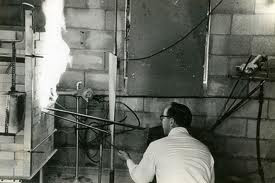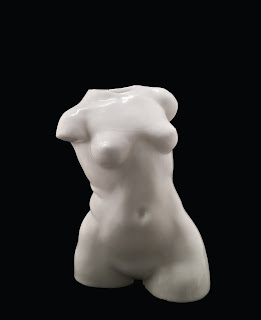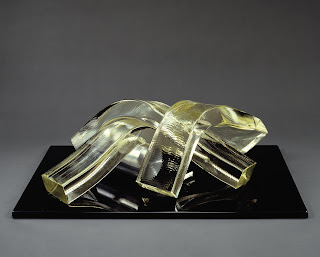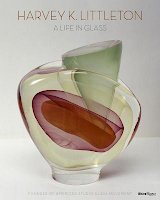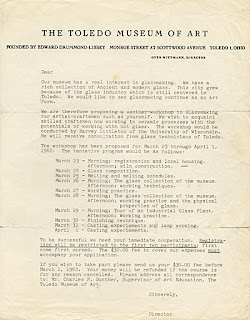>
From this. . . . . . .. . . . . . . .to this.
“It was all her idea”
The History of Pyrex
Back in the early 1900’s, Corning Glass Works was working on a request from the railroads to produce lantern glass that would not break when the hot glass was struck by rain or snow. In response to this request,
In July 1913, a series of events involving Bessie Littleton, the wife of the company’s newest scientist – Dr Jessie Littleton, forced
• The cooking time was shorter
• The cake did not stick to the glass; it was easy to remove with little adhesion
• The cake was unusually uniform
• The flavor of the cake did not remain in the dish after washing
• She could watch the cake bake and know it was done by looking at the underside.
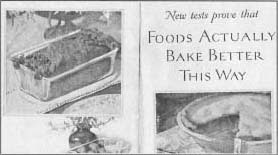
Mr. Littleton brought his wife’s creation to work the following day. Laboratory researchers inspected the cake, which was a “remarkable uniform shade of brown all over.” The men deemed it delicious and very well baked. (A favorite of any lab conclusion, Ed.) Thus began a two-year process to perfect this new invention. The notion of baking in glass was a whole new concept to the public. In 1915, a wondrous new line of “glass dishes for baking” appeared in the nation’s hardware, department and china stores. On May 18, 1915,
The
Click HERE to jump to the story of Harvey Littleton and his historic workshops that brought glass from the factory to the artists.
Other Glass Fun Facts to know and tell:
Glass Fun Facts: Gaffer/Composer
More Glass Fun Facts: Bullseye Glass
Float Glass Fun Facts
Glass Fun Facts – Shattered Glass Predicts Weather
Why is Glass Transparent?
Harvey K. Littleton and the Studio Glass Movement
>
In 1962, two groundbreaking workshops led by artist Harvey K. Littleton and glass scientist Dominick Labino introduced artists to the material of glass as a medium for artistic expression. Littleton and Labino presented their development of a small, portable furnace and low temperature melting-point glass, providing artists access to glass and glassblowing techniques for the first time. These workshops kickstarted the Studio Glass movement, which emphasized the artist as designer and maker, with a focus on making one-of-a-kind objects.
In celebration of the 50th anniversary of the American Studio Glass movement, in 2012, a number of museums will be mounting exhibitions on the history and origins of the movement.
The Corning Museum of Glass has two exhibitions that opened November 17, 2011 and will run through January 6, 2013.
In the Spring 2012: Chazen Museum of Art (University of Wisconsin, Madison) has an exhibition planned, and there is an exhibition planned for November 2, 2012 thru December 21, 2012 at the: Visual Arts Center of Richmond (Richmond, Virginia)
The man called the father of the Studio Glass Movement was not at first a glass artist. Littleton was born in 1922 and raised in Corning, New York. Throughout his childhood, he had many opportunities to observe glassworking processes and to learn about the properties of glass at the Corning Glass Works. His father, Dr. Jesse T. Littleton, known as J.T., was an expert in the infrared properties of silicon and the first physicist to join the newly established research team at Corning Glass Works headed by Dr. Eugene C. Sullivan.
J.T. Littleton often discussed the properties of glass as dinnertime conversation, and Saturday morning visits to the glassworks were routine for Littleton when he was young. In 1936, he and his brothers witnessed, with his father and many others, the dramatic failure of the first casting of the 200-inch mirror for the Hale Telescope at Mount Palomar in California.
Littleton’s mother, Bessie Cook Littleton, was instrumental in developing Corning’s Pyrex cookware. J. T. Littleton had the idea that Corning’s low-expansion borosilicate glass, which had been developed for use in battery jars (used in rural areas before widespread electrification), could be used for cooking. He took home a battery jar that had been cut into a round, shallow pan, and he convinced his wife to bake a cake in it. Her success led to the development of Corning’s Pyrex housewares.
After receiving a master of Fine Arts from Cranbrook Academy of Arts Harvey Littleton embarked on the career of potter. Littleton received recognition for his work as a ceramicist in a national exhibition sponsored by the American Crafts Council at the First International Exposition of Ceramics in Cannes, France.
In 1959 he began to investigate the possibility of glass as a medium, and in 1960 had melted glass and cold-worked lumps of cullet. In the summer of 1962 the Toledo Museum of Art invited Littleton to lead a glassblowing workshop. It was in that seminar that Littleton introduced the idea that glass could be mixed and melted, blown and worked in the studio by the artist. Up to that time it was widely believed that glass objects could only be made in the highly structured, mass-produced world of the glass industry where the labor of making glass is divided between designers and skilled craftsmen.
With Littleton’s active encouragement and promotion, glass programs sprang up at universities, art schools, and summer programs across the country during the late 1960s and early 1970s; and the Studio Glass movement became an international phenomenon. What began fifty years ago as a small group of artists who shared an interest in glass as an artistic material has grown into an international community of thousands.”
In 1984, his daughter, Maurine Littleton opened an art gallery committed to artists working in glass and ceramics in Washington DC’s historic Georgetown neighborhood.
Maurine advised on Joan Falconer Byrd‘s new book : “Harvey K Littleton: A Life in Glass” – This new book has many previously unpublished archival photographs and a detailed chronology. Images and the history of Littleton’s early ceramic and glass vessels and his richly colorful glass sculptures, among them the late “Lyrical Movement” series are detailed in this beautifully designed book. The book includes work by his close friend and European counterpart Erwin Eisch and his former student and much-celebrated glass artist Dale Chihuly.
Below is “Pioneers of Studio Glass” – a video that was produced by WGTE Public Media for the Art Alliance for Contemporary Glass. It is a fascinating look at the 1962 Toledo Workshops where Harvey Littleton and Dominick Labino first experimented with making glass outside of the factory setting.
Pioneers of Studio Glass from corecubed on Vimeo.
Glass History Lesson – Harvey Littleton 1962 Workshops
>
During the 1950s, studio ceramics and other craft media in the U.S. began to gain in popularity and importance, and artists interested in glass looked for new paths outside industry sources. At that time, access to glass was only through industrial production. Students were not taught hands-on techniques with the material; the craft of working with hot glass was still taught at the factories, under the apprenticeship system. The catalyst for the development of studio glass was Harvey Littleton, a teaching ceramist at the University of Wisconsin in Madison.
Informed by his own background in the material (he grew up in the shadow of Corning Glassworks, where his father headed Research and Development during the 1930’s), Harvey started experimenting with hot glass in his studio in 1958. He eventually realized that his desire to develop studio glassblowing could become a reality after experiencing limited success with his own glassblowing experiments.
The 1962 Toledo Workshop program
Harvey joined forces with the Toledo Museum of Art, the site of the “birth” of the American Studio Glass movement during two historic glassblowing workshops in 1962. He worked with glass research scientist Dominick Labino, who successfully devised a small, inexpensive furnace in which glass could be melted and worked, making it affordable and possible for the first time for artists to blow glass in independent studios.
Harvey Littleton subsequently started a glass program at the University of Wisconsin in Madison, and some of his early students were Dale Chihuly, Marvin Lipofsky, and Fritz Dreisbach, all artists who have played seminal roles in raising the awareness of studio glass around the world.Source: CMOG
As GlassWeekend 2011 gets started, The Washington Glass School Blog visited with Harvey’s daughter Maurine Littleton at her art gallery in Washington, DC, as she prepared for the exhibition. Maurine brought out some of the early glass pieces made by Harvey at the workshops.
Maurine Littleton discusses the early Harvey Littleton pieces. In the background are Harvey Littleton works ca 1986.
Two Harvey Littleton vases from the 1962 Toledo workshop. The pieces are engraved on the bottom with Harvey’s name and date.
Harvey’s first pieces in blown glass were, like his earlier works in pottery, functional forms: vases, bowls and paperweights. His breakthrough to non-functional form came in 1963 when, with no purpose in mind, he remelted and finished a glass piece that he had earlier smashed in a fit of anger. The object lay in his studio for several weeks before he decided to grind the bottom. As Harvey recounts in his 1971 book Glassblowing: A Search for Form, he brought the object into the house where “it aroused such antipathy in my wife that I looked at it much more closely, finally deciding to send it to an exhibition. Its refusal there made me even more obstinate, and I took it to New York … I later showed it to the curators of design at the Museum of Modern Art. They, perhaps relating it to some other neo-Dada work in the museum, purchased it for the Design Collection.”
Harvey’s birthday is June 14th – he turns 89 this year. Everyone here at the Washington Glass School sends Harvey Best Wishes for a Happy Birthday!
The Smithsonian Institution has a fascinating oral history interview with Harvey – made in 2001. Click HERE to jump to the SI web-link.
